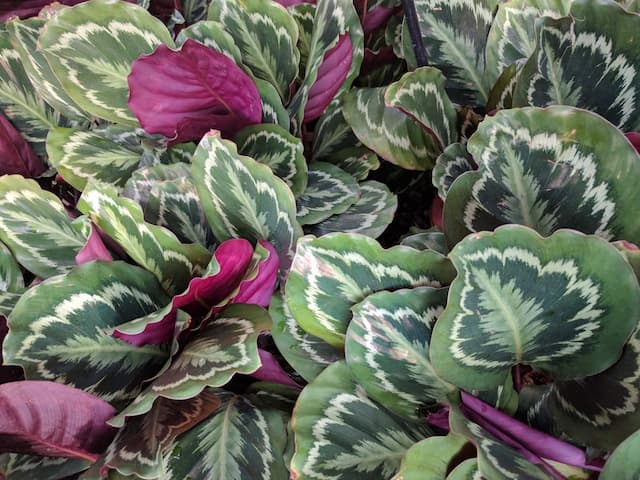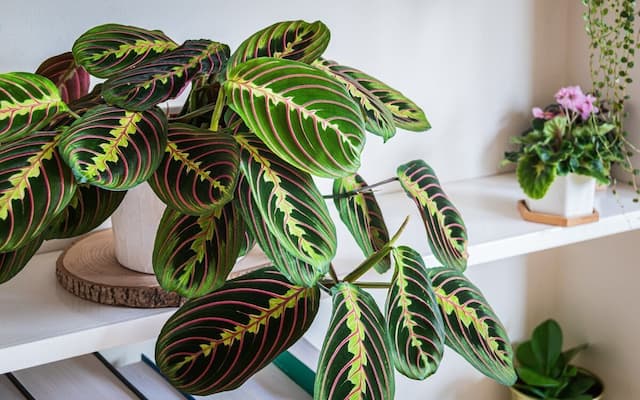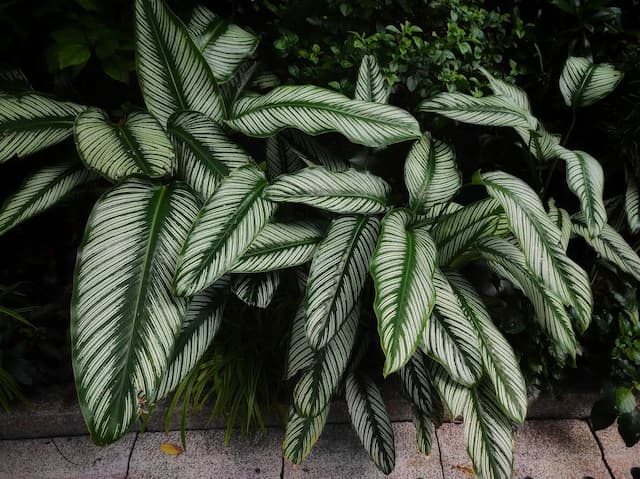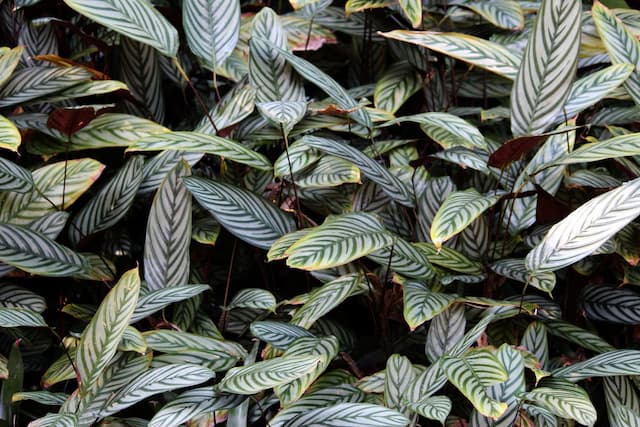Prayer Plant Maranta leuconeura var. kerchoveana

ABOUT
The prayer plant, also referred to by its specific variant name, features striking foliage which often draws the admiration of plant enthusiasts. The leaves are broad and oval-shaped with a velvety texture. What's most distinctive about this plant is the pattern on its leaves; they showcase a beautiful array of dark green splotches arranged symmetrically on either side of the central vein, which remains a lighter green. The underside of the leaves is equally striking, typically colored in a rich purple hue. Adding to its charm, the leaves are dynamic; they move in response to the light, opening out to absorb light during the day and folding upright in the evening, resembling hands in prayer, ultimately giving the plant its common name. The prayer plant has delicately thin stems, which allow the leaves to move with a sort of delicate grace. Blooms from this plant are inconspicuous when compared to its vibrant foliage, usually small and white, and not the main attraction. Its overall appearance is lush and has an exotic tropical feel, which provides an eye-catching greenery display in homes and shaded garden spaces.
About this plant
 Names
NamesSynonyms
Prayer Plant, Rabbit's Tracks, Green Maranta.
Common names
Maranta kerchoveana, Maranta massangeana, Maranta verschaffeltii, Phrynium variegatum.
 Toxicity
ToxicityTo humans
The Prayer Plant is generally considered non-toxic to humans. Consequently, ingesting parts of this plant typically does not lead to poisoning or serious health consequences. However, it is always advisable to keep plants out of the reach of small children, as individual reactions can vary, and plant parts are not intended for consumption.
To pets
The Prayer Plant is also non-toxic to pets such as cats and dogs. It does not usually cause any severe symptoms of poisoning if pets ingest it. Despite this, pet owners should still monitor their pets to prevent any gastrointestinal discomfort that might occur if the plant is consumed in large amounts.
 Characteristics
CharacteristicsLife cycle
Perennials
Foliage type
Evergreen
Color of leaves
Variegated
Height
1-2 feet (0.3-0.6 meters)
Spread
1-2 feet (0.3-0.6 meters)
Plant type
Herb
Hardiness zones
11
Native area
Tropical Americas
Benefits
 General Benefits
General Benefits- Easy Care – The Prayer Plant is known for being easy to care for, making it suitable for beginner gardeners.
- Attractive Foliage – It has visually appealing patterned leaves that can add aesthetic value to indoor spaces.
- Pet Friendly – The plant is non-toxic to cats and dogs, which is important for pet owners.
- Mood Enhancer – Like many houseplants, it can enhance the mood by adding greenery and a sense of nature to a room.
- Low Light Requirements – It thrives in low-light conditions, making it ideal for spaces with limited natural light.
- Humidity Tolerance – It prefers higher humidity levels, which can be beneficial in dry indoor environments.
 Medical Properties
Medical PropertiesThis plant is not used for medical purposes.
 Air-purifying Qualities
Air-purifying QualitiesThis plant is not specifically known for air purifying qualities.
 Other Uses
Other Uses- Prayer Plant leaves can be used as a natural dye for fabrics and paper, providing a range of green hues when treated with mordants.
- The striking pattern of the Prayer Plant's leaves makes it an excellent subject for botanical illustration and plant photography tutorials.
- Its non-toxic properties make the Prayer Plant a safe addition to homes with pets, where it can be used in pet-friendly indoor landscaping designs.
- Due to its novel leaf movements, the Prayer Plant can be utilized in educational settings to demonstrate nyctinastic movement in plants.
- The Prayer Plant can be included in terrariums and fairy gardens, where miniature landscapes can highlight its intricate leaf patterns.
- The high humidity requirements of the Prayer Plant make it a suitable companion for increasing humidity in collections of tropical butterflies or other humidity-loving insects in educational exhibits.
- Its vivid leaf colors and patterns can be used by interior designers to add a splash of color in minimalist or monochrome spaces.
- The leaves of Prayer Plants can serve as inspiration for artists and designers, influencing patterns and motifs in textiles, wallpaper, and other decorative arts.
- For those interested in sustainable and eco-friendly holiday decorations, the Prayer Plant's vibrant leaves can be fashioned into living ornaments or table centerpieces.
- Within a biophilic design approach, the inclusion of Prayer Plants may contribute to enhanced well-being by bringing in natural elements that may subliminally remind individuals of the outdoors.
Interesting Facts
 Feng Shui
Feng ShuiThe Prayer Plant is not used in Feng Shui practice.
 Zodiac Sign Compitability
Zodiac Sign CompitabilityThe Prayer Plant is not used in astrology practice.
 Plant Symbolism
Plant Symbolism- Prayer - Maranta leuconeura, commonly known as the Prayer Plant, gets its name because its leaves fold together at night, as if in prayer, symbolizing spirituality and the act of turning inward.
- Gratitude - Often given as a gift, the Prayer Plant can symbolize thankfulness and appreciation for another person, reflecting a gesture of gratitude.
- Personal Growth - The opening and closing of the leaves of the Prayer Plant can also represent personal growth and the adaptation to life's rhythms and changes.
 Water
WaterTo properly water a Prayer Plant, it’s recommended to maintain a consistent moisture level without waterlogging the soil. Water the plant when the top inch of the soil feels dry, which could be approximately once a week, but frequency depends on environmental conditions. Use room-temperature water and add it gently around the plant until it starts to drain from the bottom of the pot. Avoid letting the plant sit in standing water. Typically, it may need about 8-16 ounces of water for a medium-sized pot, but always adjust based on the soil's moisture content and the plant's response.
 Light
LightPrayer Plants prefer bright, indirect light and should never be exposed to direct sunlight, as it can cause leaf burn and fade their vibrant colors. The best spot for a Prayer Plant is near a north or east-facing window where it can receive plenty of diffused natural light. However, it can also adapt to lower light conditions if necessary, making it suitable for indoor environments with less natural light availability.
 Temperature
TemperaturePrayer Plants thrive in a temperature range between 60 and 80 degrees Fahrenheit, which is comfortable for most indoor settings. They can endure a minimum temperature of 55 degrees Fahrenheit but should not be exposed to cold drafts or sudden temperature changes. The ideal conditions for a Prayer Plant include warm and consistent temperatures without any extremes.
 Pruning
PruningPruning Prayer Plants promotes bushier growth and removes any yellow or brown leaves that may occur due to natural aging or environmental stress. Prune by snipping off the unwanted foliage at the base of the leaf stem, preferably during spring or early summer when the plant is actively growing. This also keeps the plant looking tidy and allows for better air circulation. Regularly deadheading spent leaves every month or as needed should suffice.
 Cleaning
CleaningAs needed
 Soil
SoilPrayer Plant prefers well-draining, fertile soil with a peat-based mix. The ideal soil pH should be slightly acidic to neutral, between 5.5 and 6.5. A recommended soil mix could include equal parts peat, perlite, and potting soil to facilitate adequate drainage and retain appropriate moisture levels.
 Repotting
RepottingPrayer Plants typically require repotting every 1-2 years to ensure that they have enough space to grow and to refresh the soil. It is best to repot in spring or early summer, when the plant is in its active growth phase.
 Humidity & Misting
Humidity & MistingPrayer Plants thrive in high humidity environments, ideally between 40% to 60%. To maintain these conditions, you can place a humidifier nearby, set the pot on a humidity tray, or group the plant with other houseplants to create a microclimate with higher moisture.
 Suitable locations
Suitable locationsIndoor
Keep in bright, indirect light, high humidity, and warm temperatures.
Outdoor
Shelter from direct sun, ensure high humidity, protect from cold.
Hardiness zone
11-12 USDA
 Life cycle
Life cycleThe life of the Prayer Plant (Maranta leuconeura var. kerchoveana) begins with germination, where the seeds sprout when provided with the right warmth and moisture conditions. After germination, the seedling stage is characterized by the emergence of initial leaves and the establishment of roots. The vegetative growth stage sees the development of the plant’s characteristic patterned leaves and branching stems as it matures. During its maturity, the Prayer Plant may produce small, inconspicuous white flowers, although it is primarily grown for its attractive foliage rather than its blooms. The plant continues to grow by producing offsets, which can be separated to produce new plants, a form of asexual reproduction. Eventually, the plant reaches senescence, where growth slows, leaves may drop, and the plant will die, although this life span can be quite long with proper care.
 Propogation
PropogationPropogation time
Spring-Summer
The Prayer Plant, known scientifically as Maranta leuconeura var. kerchoveana, can be propagated through division or cuttings, preferably in the spring or early summer when the plant's growth is most active. The most popular method of propagation for prayer plants is through stem cuttings. To propagate, take a stem cutting of about 4 to 6 inches long, ensuring there are at least one or two nodes on the cutting. Remove the leaves from the lower half to expose the nodes. These nodes, when placed in water or moist potting soil, will initiate root growth. If using water, place the cutting in a clear container filled with room-temperature water, ensuring the nodes are submerged. Roots typically begin to form within a few weeks, after which the new plant can be potted in soil. If propagating in soil, choose a potting mix that drains well, moisten it, and plant the cutting, making sure the nodes are buried. Keep the soil consistently moist but not waterlogged, and place the pot in indirect light until new growth signifies that the cutting has successfully taken root.




